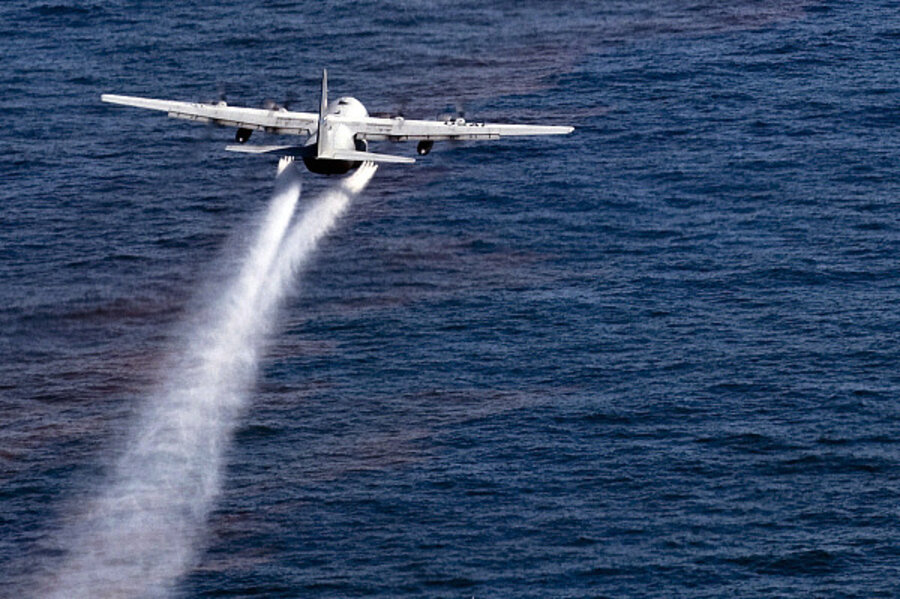As BP oil spill fight continues, more areas closed to the public
Loading...
| Robert, La.
With confirmed sightings of oil across a 50-mile chain of islands that line Louisiana’s Southwestern coast, the National Oceanic and Atmospheric Association (NOAA) has ordered the affected area closed to public entry. The agency also expanded an earlier ban on fishing in the area east of the Mississippi River.
Last Sunday, NOAA announced a ten-day ban on all recreational and commercial fishing between the mouth of the Mississippi River and Florida’s Pensacola Bay. That set off alarms for the state’s fishing industry, which is the second largest in the US, producing up to 25 percent of the total domestic seafood in the lower 48 states. Commercial fishermen harvested more than 1 billion pounds of finfish and shellfish in 2008.
The Chandeleur Islands chain represents the first shorelines to receive oil from the April 20 BP oil spill and tanker collapse that NOAA says is releasing 210,000 gallons of oil per day into the Gulf of Mexico. The US Fish and Wildlife Service closed the islands Friday after sightings showed oil on both sides of the chain’s southern half.
IN PICTURES: Louisiana oil spill
The expanding ban now applies to about 4.5 percent of total Gulf waters under federal jurisdiction. However, for fisheries the area is also among the most fertile areas for bountiful catches, which is why both Louisiana and Mississippi are pressing NOAA to declare a fisheries disaster.
Recovery efforts have yet to fully prevent the daily discharge of oil from the underwater wells. Emergency response efforts like the use of chemical dispersants are proving controversial because little is known about the compounds used and what, if any, effect they may present for marine life.
Surface burning was ineffective earlier in the week due to multiple days of rainstorms and harsh winds, which recently subsided.
“We’re very thankful for the [clear] weather, it’s responsible for probably our most productive days,” said US Coast Guard Rear Adm. Mary Landry at a press conference Friday. To date about 9,000 barrels of oil have been burned, Adm. Landry said.
Recovery booms are being placed along the coast to capture the oil before it moves inward. Although the booms collected over 50,000 barrels of oil-infested water, BP Chief Operating Officer Doug Suttles admitted that “skimming operations are not efficient” because they depend on how concentrated the oil is in the water. Mr. Suttles said it is likely that 90 percent of what was collected this week is water.
The latest technology being used is a four-story containment dome, which was placed into the water on the way to the ocean’s floor Thursday to stop the oil from spreading.
Adm. Landry warned that the dome “is not the final solution” or a substitute for “cementing and closing off this well.” She added that because the technology is experimental, there will likely be complications. Already it is known the dome will only be placed over a single leak. If successful, a second dome will be constructed to cover the remaining leak.
“This is going to take a few days. It may or may not work,” she said.
Besides a call for Senate hearings and talk from the White House about raising the liability cap required by BP to cover damages to local communities, federal officials are stepping up pressure on the oil industry by demanding safety inspections of 30 deepwater facilities that operate in Gulf waters. The results of the inspection will be issued soon, Landry said.
On Thursday US Interior Secretary Ken Salazar announced a three-week halt to all new oil drilling permits. However the ban does not affect an existing permit for Shell Oil to begin offshore oil drilling in Alaska’s Chukchi Sea in July.
Environmental groups cheered news of the moratorium but said it did not go far enough, and they criticized President Obama’s decision in March to open up offshore drilling in Alaska, the eastern Gulf, and the Atlantic Coast.
Shipping through the Mississippi River continues at full speed, despite the oil spill.
The coast guard has constructed facilities near the river’s mouth to spray all vessels of possible oil contaminant as they pass through.
“They haven’t had to clean a ship yet,” says Robert Scafidel, executive director of the St. Bernard Port, Harbor and Terminal District, about 15 miles outside New Orleans. “We don’t want to see the coast with oil. But right now it looks like the deepwater vessels are clean.”
IN PICTURES: Louisiana oil spill
Related:
Tricky maneuver: Will containment cap stop the BP oil spill?





